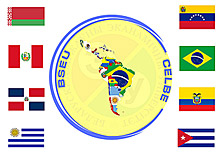Aleksandr Saharov
Peculiarities of economic and socio-political integration of Latin American countries
The Latin American and the Carribean region is strengthening its position as one of the centers of influence in the emerging multipolar world. Latin America possesses enormous natural resources. The interest to Latin America is reinforced with the circumstance that it is the countries of Southern Hemisphere, which demonstrate the highest rates of economic growth. The role of Latin American foreign policy, its degree of independence in international affairs is increasing significantly. Many countries are seeking to acquire business partners, resources and friends in Latin America and are interested in mutual development and cooperation.
The countries of Latin America and the Carribean form a huge territory, occupying almost half of the Western Hemisphere, or 15% of planetary land with large oil reserves. Nowadays it is difficult to find such a vast and populous (up to 9% of habitants) macro-region with such a homogeneous characteristics. Here are a close linguistic affinity, a clear dominance of religion – Catholicism, similarity of historical destinies and a long affiliation to the periphery of the world economy and world politics, a high level of education and human resources.
The very birth of Latin America marked the emergence of the world market, the world economy – when the circle of the world space has closed physically after the discovery by Christopher Columbus and the colonization of the New World.
Also it is necessary to remember that the start of the capitalist era was provided with the massive money material from Spanish America. In the XIX century after the gaining of independence by the majority of continental countries there was formed the most extensive territory in the world with the republican system, and in this respect Latin America surpassed predominantly monarchical Europe.
In the XX century Latin America was the most peaceful macro-region of the planet, in terms of numbers there were less victims of intergovernmental armed conflicts than in other regions of the world.
Latin American integration is associated with a variety of initiatives.
For a long time Latin America has been on the periphery of the global processes. According to the Monroe Doctrine, established in 1823, the USA could interfere in the internal affairs of the countries of Latin America and the Carribean.
It was established the Organization of American States in order to strengthen US influence in Latin America. A striking example of the pressure can be called the exception of Cuba from this organization and the subsequent blockade.
Central American Common market represents an industry union of the countries and a free trade zone, and the formation of the customs union is constrained by the countries, which are afraid to suffer losses after its creation that requires a coordination of external tariff, common laws.
The main objectives of the Andean Community of Nations are to develop a common economic policy, coordinate joint projects, harmonize the legislation to simplify the mechanisms for participation in the integration processes in the region, reduce the level of foreign economic vulnerability and strengthen regional solidarity.
The states of the Carribean Community represent themselves as suppliers of agricultural and mineral raw material, «maquiladoras» products, as well as travel and financial services. Integration processes within CARICOM affect cooperation in trade and industry, education, health and foreign policies, coordination of foreign economic policy.
In Mercosur the focus is on trade relations. It is important to note that on the territory of member countries of Mercosur there are 2/3 of water reserves in the region and 20% of world oil reserves.
The purpose of the Bolivarian Alliance for the Peoples of Latin America is the cooperation and the intensification of trade relations, the formation of a unified American nation, maintaining national security, creation of a common bank. The single currency was introduced – «sucre» as the alternative to the US dollar. Ideologically, the project is based on the ideas of Latin American national heroes Simon Bolivar, Jose de San Martin, whose aspirations were aimed at creation of anunion based on the ideas of social equality, freedom of realization, mutual support.
On the territory of the member countries of Unasurthere are many tropical forests, so the country have a policy of collective defense of biodiversity and defend jointly interests of one of its members, also it provides monetary and energy integration.
Community of Latin American and Caribbean States has united all the countries of South, Central and North America, with the exception of the USA and Canada. The main objectives of CELAC are to accelerate energy integration, defend common position on the international arena, protect and distribute Latin American and Caribbean identity.
Thus, the key peculiarities of the integration of Latin American countries are striving to get rid of the influence of the United States, the movement towards a multipolar world order, the search for allies and partners such as Belarus, Russia, China, relations with which are conditioned by the unanimity of leadership on key political, economic and social issues, as well as a high level of mutual trust and the policy of cooperation in high-tech fields, and mutual development.
